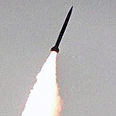

The Wall Street Journal reported Thursday that Syria has already paid for part of the system's costs. In response, Israel turned to the highest ranks in Russia and the US in order to stop the supply of the missiles to Syria.
It can be assumed that the conversation held between US President Barack Obama and Prime Minister Benjamin Netanyahu was about the issue of Russian threats to arm the Syrian forces. The Israeli request was made in the last 48 hours to defense and state personnel working directly with President Putin and the White House.
The S-300 is a Russian system made to intercept aircraft at ranges of over 100 km (60 miles) as well as ballistic missiles. It is unknown exactly which model Russia intends to sell to the Syrians, although it is known that Syria has asked in the past for the model referred to by NATO as the SA10.
A few years ago, when it was discovered that Russia was about to supply these missiles to Syria, Israel and the US turned to the Kremlin, which led to the suspension of the deal.
Cyprus on the other hand has received the SA10 missiles and Iran has also been trying for years to get a similar and newer model from Russia – the SA-400.
It is estimated that Russia eventually wants to reach a deal with the US and its NATO allies in which the US will commit not to supply the rebels with weapons against Assad or launch a military intervention in Syria, and in return the Russians would not supply the Syrians with the system or its newer model.
Russia had already signed a deal with Iran for supplying these missiles, and Iranian operators have already trained in their use in Russia. However, following Putin's visit to Israel and as a result of direct US pressure, this deal was also suspended, yet not canceled altogether.
The US and Israeli argument was that if the Russians supplied Iran with the SA400, it would not be possible to maintain a credible military threat on Iran's nuclear facilities, since the SA400 system can harm aircrafts within 156 km (97 miles) also in relatively low altitudes. According to the Russians, the system is also capable of intercepting ballistic missiles.
As part of its efforts to persuade Iran to abandon its military nuclear program, Russia accepted the Israeli and US request and suspended the deal.
A similar course of events happened in the past with the supply of SA300/SA10 missiles to Syria. Israel made clear to the Russian that having these anti-aircraft missile systems in Syria would neutralize Israel's ability to defend itself since the system would be capable of hitting aircrafts not only above Lebanon and Syria, but also immediately when they take off out of almost every base in the center and north of Israel. Russia accepted the argument.
It appears Moscow is now re-considering supplying the system to Syria out of two reasons: the first, to deter the US and NATO allies from an aerial military intervention in Syria, and the second to deter the US from providing the rebels with modern weapons.
- Receive Ynetnews updates
directly to your desktop















